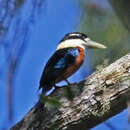pt-BR
nomes no trilho de navegação


The four species of Kookaburras (Dacelo) are kingfishers found in Australia, New Guinea, and nearby islands.
The Rufous-bellied Kookaburra (D. gaudichaud) is found in the New Guinea lowlands and nearby islands. This large kingfisher is found mainly in the lower canopy of monsoon and riverine forest, but also in primary rainforest, floodplain forest, parkland, secondary growth, thick coastal palm scrub, mangroves, and gardens. It may also use isolated patches of land in cleared areas, and Teak (Tectona grandis) or Rain Tree (Samanea saman) plantations. For breeding, Rufous-bellied Kookaburras require arboreal termitaria. Although these kingfishers are generally found below 500 m elevation, they have been recorded up to 1300 m. The diet consists of arthropods and small vertebrates, with most foraging in the lower canopy. The nest is excavated in an active termite nest, typically 2 to 40 m above the ground in a tree. Clutch size is 2 eggs and young are fed by both parents. Rufous-bellied Kookaburras are common and widely distributed in New Guinea.
Spangled Kookaburras (D. tyro) are found in southern New Guinea and (historically) the Aru Islands in wooded dry savanna, in thickets of Dillenea alata on swamp margins, and in mosaics of monsoon forest, thickets, and Melaleuca savanna woodland, as well as in dense monsoon and riverine forest. They keep mostly to the understorey, feeding mainly from a perch 1 to 4 m high. The Spangled Kookaburra's nest is excavated in a termitarium above the ground (it is possible that tree cavities are used as well). Although the Spangled Kookaburra is relatively common within its range, the restricted distribution make the species somewhat vulnerable.
Blue-winged Kookaburras (D. leachii) are found in northern Australia and southern New Guinea. They occur in savanna woodland and Eucalyptus open woodland and forest, in tall trees and woodland along watercourses, and in riverine and littoral mangrove and monsoon forest. They avoid areas with a dense understorey. They may also be found in pastures and cultivated land with stands of trees, in plantations far from water, and in large suburban parks and gardens. Although they are found mainly in the lowlands in New Guinea, they can be found locally to 600 m. Where its range overlaps with that of the Laughing Kookaburra (D. novaeguineae), the Blue-winged Kookaburra is usually more common away from water. The diet includes a wide variety of arthropods, snails, earthworms, and small vertebrates. Blue-winged Kookaburras hunts from a perch, typically 2 to 4 m above the ground. They may breed as a pair or in a group of up to 12 individals, but most commonly in a group of 3. The extra "helper(s)" are young from the previous several years. Nests are in tree cavities or in termite nests on the ground or in trees. Blue-winged Kookaburras are fairly common over most of their range.
The Laughing Kookaburra (D. novaeguineae) is found in eastern and southwestern Australia in Eucalyptus forest and woodland, using riparian trees along major watercourses to extend inland or into primary forest. Laughing Kookaburras are also found on wooded and cleared farmland and in city parks and suburban gardens so long as appropriate nesting cavities are available. In some areas of overlap with the Blue-winged Kookaburra, the two species are interspecifically territorial; in other areas, Blue-winged Kookaburras use drier habitats. The Laughing Kookaburra's well studied diet includes earthworms, snails, diverse arthropods, and small vertebrates. Most prey is taken from the ground. Snakes up to 1 m long may be grabbed behind the head, beaten violently on the ground or on a perch, then swallowed head first. Scraps may be taken at picnic areas. Undigested food is regurgitated as pellets, which accumulate beneath regular roosting sites. A breeding pair is often assisted by 4 or 5 "helpers", mostly male young from previous years.Lifespan in the wild is up to around 11 years. The Laughing Kookaburra is common over most of its range and has generally benefited from human settlement, although density declines where farmland is converted to housing.
(Woodall 2001 and references therein)